Nursing Research: COPD, Palliative Care, and Oxygen Therapy Outcomes
VerifiedAdded on 2023/06/11
|5
|1151
|102
Report
AI Summary
This report provides an overview of Chronic Obstructive Pulmonary Disease (COPD), defining it as a universal term encompassing diseases like emphysema, chronic bronchitis, and refractory asthma, all characterized by increased breathlessness. It emphasizes that while COPD is progressive and incurable, proper diagnosis and management can improve breathing. The report includes a detailed PICOT statement focusing on the smoking population at risk, the role of palliative care as a key intervention, oxygen therapy as a comparative treatment, and the expected outcome of prolonging life and improving symptoms rather than achieving a cure. It concludes by highlighting the importance of PICOT statements in nursing practice for guiding treatment protocols and managing patient care effectively, particularly in chronic conditions like COPD where the focus is on enhancing the patient's quality of life.
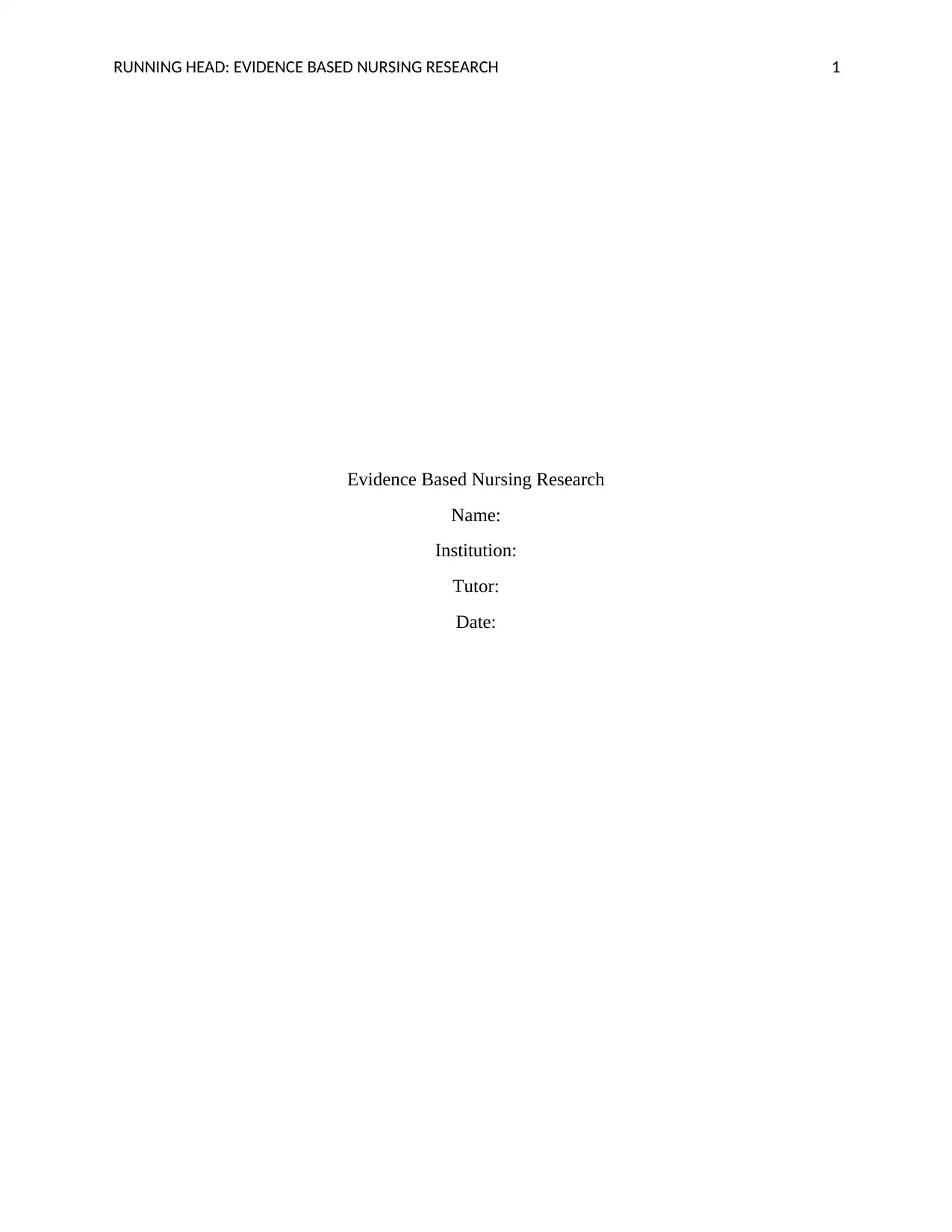
RUNNING HEAD: EVIDENCE BASED NURSING RESEARCH 1
Evidence Based Nursing Research
Name:
Institution:
Tutor:
Date:
Evidence Based Nursing Research
Name:
Institution:
Tutor:
Date:
Paraphrase This Document
Need a fresh take? Get an instant paraphrase of this document with our AI Paraphraser
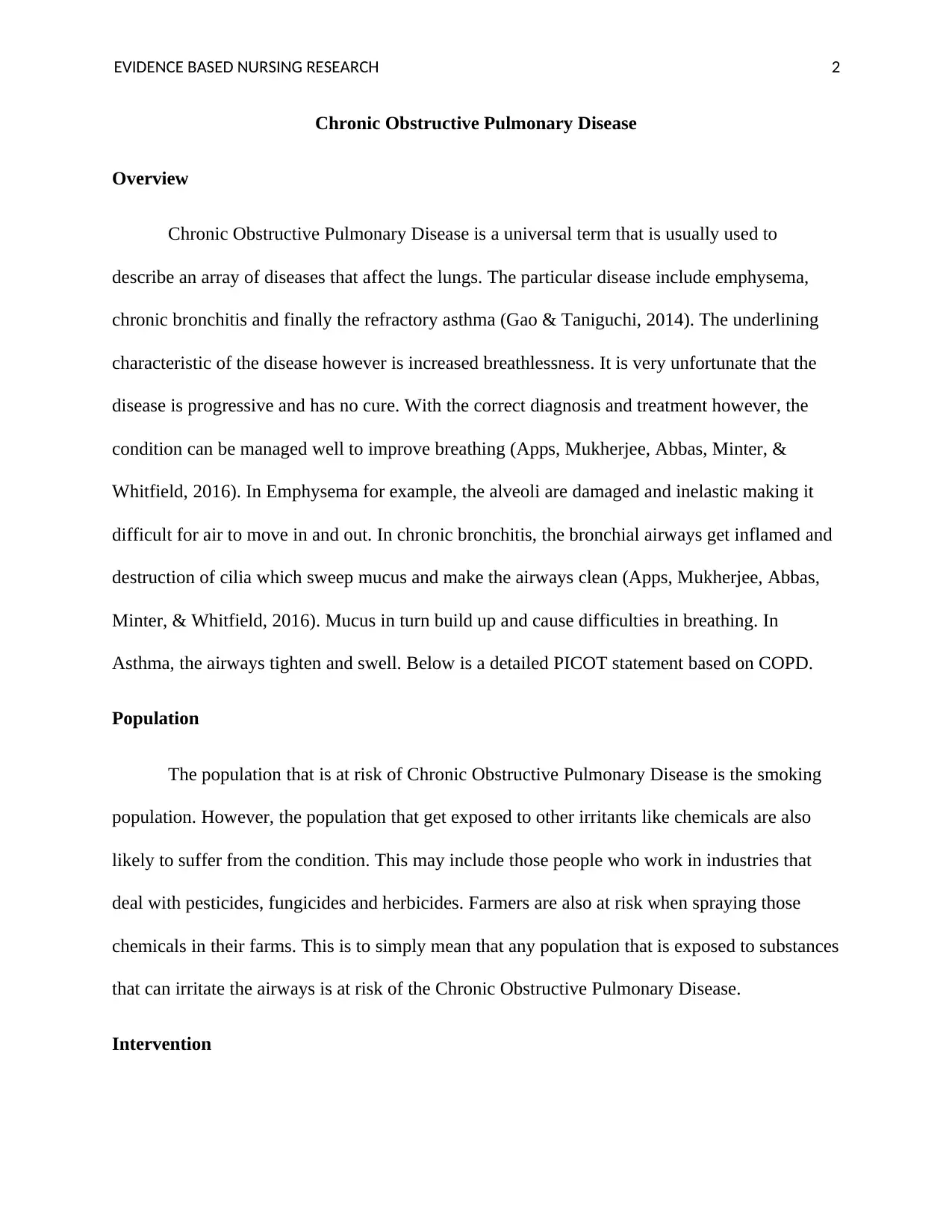
EVIDENCE BASED NURSING RESEARCH 2
Chronic Obstructive Pulmonary Disease
Overview
Chronic Obstructive Pulmonary Disease is a universal term that is usually used to
describe an array of diseases that affect the lungs. The particular disease include emphysema,
chronic bronchitis and finally the refractory asthma (Gao & Taniguchi, 2014). The underlining
characteristic of the disease however is increased breathlessness. It is very unfortunate that the
disease is progressive and has no cure. With the correct diagnosis and treatment however, the
condition can be managed well to improve breathing (Apps, Mukherjee, Abbas, Minter, &
Whitfield, 2016). In Emphysema for example, the alveoli are damaged and inelastic making it
difficult for air to move in and out. In chronic bronchitis, the bronchial airways get inflamed and
destruction of cilia which sweep mucus and make the airways clean (Apps, Mukherjee, Abbas,
Minter, & Whitfield, 2016). Mucus in turn build up and cause difficulties in breathing. In
Asthma, the airways tighten and swell. Below is a detailed PICOT statement based on COPD.
Population
The population that is at risk of Chronic Obstructive Pulmonary Disease is the smoking
population. However, the population that get exposed to other irritants like chemicals are also
likely to suffer from the condition. This may include those people who work in industries that
deal with pesticides, fungicides and herbicides. Farmers are also at risk when spraying those
chemicals in their farms. This is to simply mean that any population that is exposed to substances
that can irritate the airways is at risk of the Chronic Obstructive Pulmonary Disease.
Intervention
Chronic Obstructive Pulmonary Disease
Overview
Chronic Obstructive Pulmonary Disease is a universal term that is usually used to
describe an array of diseases that affect the lungs. The particular disease include emphysema,
chronic bronchitis and finally the refractory asthma (Gao & Taniguchi, 2014). The underlining
characteristic of the disease however is increased breathlessness. It is very unfortunate that the
disease is progressive and has no cure. With the correct diagnosis and treatment however, the
condition can be managed well to improve breathing (Apps, Mukherjee, Abbas, Minter, &
Whitfield, 2016). In Emphysema for example, the alveoli are damaged and inelastic making it
difficult for air to move in and out. In chronic bronchitis, the bronchial airways get inflamed and
destruction of cilia which sweep mucus and make the airways clean (Apps, Mukherjee, Abbas,
Minter, & Whitfield, 2016). Mucus in turn build up and cause difficulties in breathing. In
Asthma, the airways tighten and swell. Below is a detailed PICOT statement based on COPD.
Population
The population that is at risk of Chronic Obstructive Pulmonary Disease is the smoking
population. However, the population that get exposed to other irritants like chemicals are also
likely to suffer from the condition. This may include those people who work in industries that
deal with pesticides, fungicides and herbicides. Farmers are also at risk when spraying those
chemicals in their farms. This is to simply mean that any population that is exposed to substances
that can irritate the airways is at risk of the Chronic Obstructive Pulmonary Disease.
Intervention
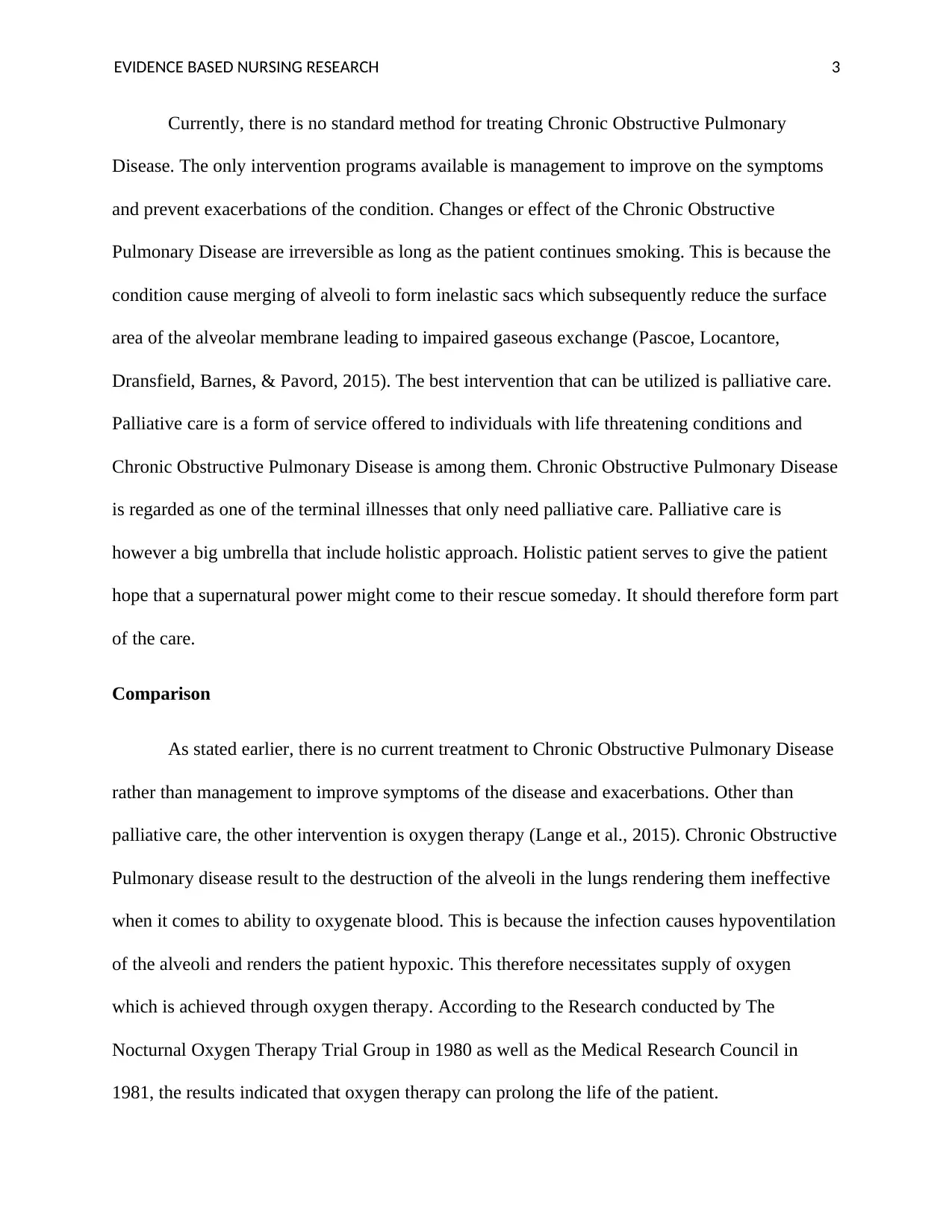
EVIDENCE BASED NURSING RESEARCH 3
Currently, there is no standard method for treating Chronic Obstructive Pulmonary
Disease. The only intervention programs available is management to improve on the symptoms
and prevent exacerbations of the condition. Changes or effect of the Chronic Obstructive
Pulmonary Disease are irreversible as long as the patient continues smoking. This is because the
condition cause merging of alveoli to form inelastic sacs which subsequently reduce the surface
area of the alveolar membrane leading to impaired gaseous exchange (Pascoe, Locantore,
Dransfield, Barnes, & Pavord, 2015). The best intervention that can be utilized is palliative care.
Palliative care is a form of service offered to individuals with life threatening conditions and
Chronic Obstructive Pulmonary Disease is among them. Chronic Obstructive Pulmonary Disease
is regarded as one of the terminal illnesses that only need palliative care. Palliative care is
however a big umbrella that include holistic approach. Holistic patient serves to give the patient
hope that a supernatural power might come to their rescue someday. It should therefore form part
of the care.
Comparison
As stated earlier, there is no current treatment to Chronic Obstructive Pulmonary Disease
rather than management to improve symptoms of the disease and exacerbations. Other than
palliative care, the other intervention is oxygen therapy (Lange et al., 2015). Chronic Obstructive
Pulmonary disease result to the destruction of the alveoli in the lungs rendering them ineffective
when it comes to ability to oxygenate blood. This is because the infection causes hypoventilation
of the alveoli and renders the patient hypoxic. This therefore necessitates supply of oxygen
which is achieved through oxygen therapy. According to the Research conducted by The
Nocturnal Oxygen Therapy Trial Group in 1980 as well as the Medical Research Council in
1981, the results indicated that oxygen therapy can prolong the life of the patient.
Currently, there is no standard method for treating Chronic Obstructive Pulmonary
Disease. The only intervention programs available is management to improve on the symptoms
and prevent exacerbations of the condition. Changes or effect of the Chronic Obstructive
Pulmonary Disease are irreversible as long as the patient continues smoking. This is because the
condition cause merging of alveoli to form inelastic sacs which subsequently reduce the surface
area of the alveolar membrane leading to impaired gaseous exchange (Pascoe, Locantore,
Dransfield, Barnes, & Pavord, 2015). The best intervention that can be utilized is palliative care.
Palliative care is a form of service offered to individuals with life threatening conditions and
Chronic Obstructive Pulmonary Disease is among them. Chronic Obstructive Pulmonary Disease
is regarded as one of the terminal illnesses that only need palliative care. Palliative care is
however a big umbrella that include holistic approach. Holistic patient serves to give the patient
hope that a supernatural power might come to their rescue someday. It should therefore form part
of the care.
Comparison
As stated earlier, there is no current treatment to Chronic Obstructive Pulmonary Disease
rather than management to improve symptoms of the disease and exacerbations. Other than
palliative care, the other intervention is oxygen therapy (Lange et al., 2015). Chronic Obstructive
Pulmonary disease result to the destruction of the alveoli in the lungs rendering them ineffective
when it comes to ability to oxygenate blood. This is because the infection causes hypoventilation
of the alveoli and renders the patient hypoxic. This therefore necessitates supply of oxygen
which is achieved through oxygen therapy. According to the Research conducted by The
Nocturnal Oxygen Therapy Trial Group in 1980 as well as the Medical Research Council in
1981, the results indicated that oxygen therapy can prolong the life of the patient.
⊘ This is a preview!⊘
Do you want full access?
Subscribe today to unlock all pages.

Trusted by 1+ million students worldwide
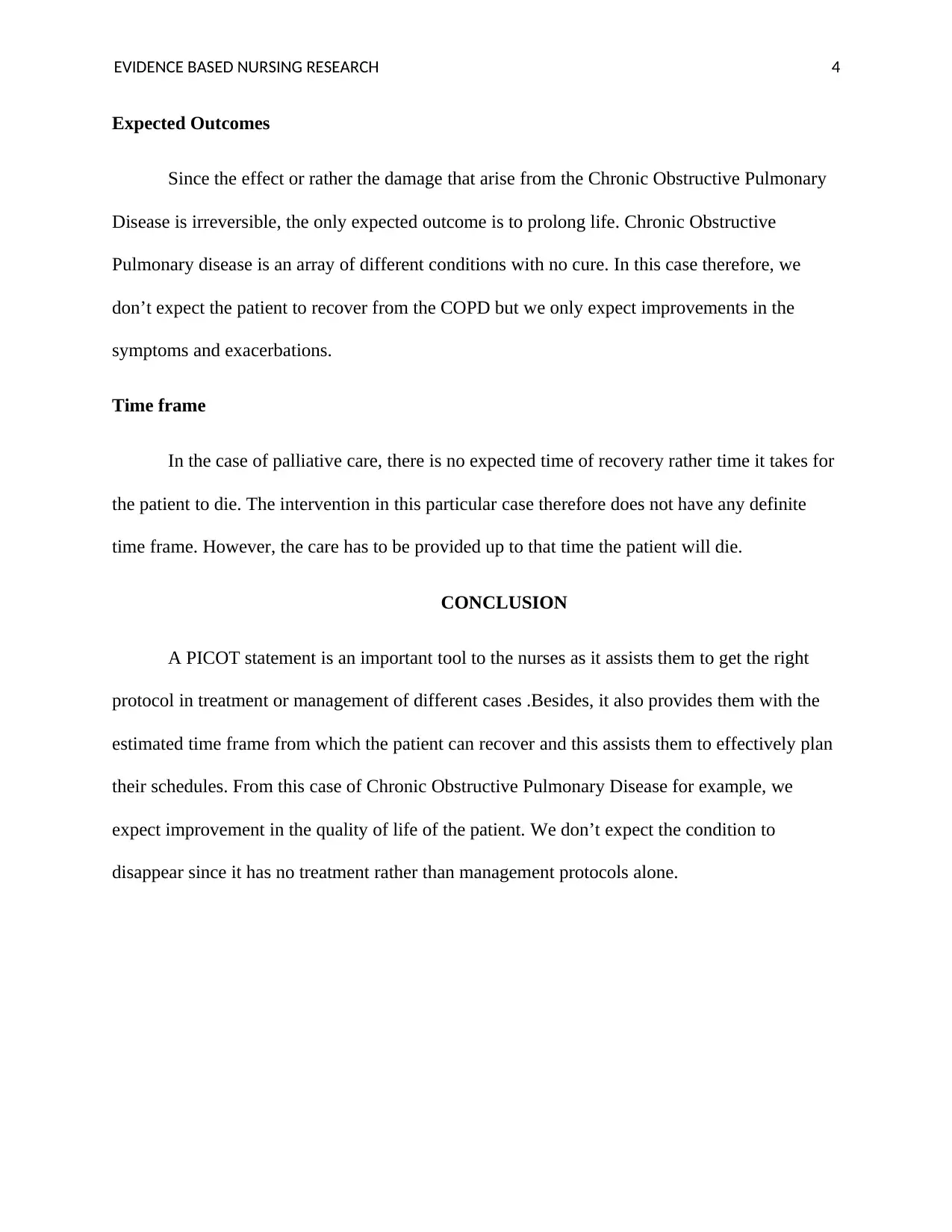
EVIDENCE BASED NURSING RESEARCH 4
Expected Outcomes
Since the effect or rather the damage that arise from the Chronic Obstructive Pulmonary
Disease is irreversible, the only expected outcome is to prolong life. Chronic Obstructive
Pulmonary disease is an array of different conditions with no cure. In this case therefore, we
don’t expect the patient to recover from the COPD but we only expect improvements in the
symptoms and exacerbations.
Time frame
In the case of palliative care, there is no expected time of recovery rather time it takes for
the patient to die. The intervention in this particular case therefore does not have any definite
time frame. However, the care has to be provided up to that time the patient will die.
CONCLUSION
A PICOT statement is an important tool to the nurses as it assists them to get the right
protocol in treatment or management of different cases .Besides, it also provides them with the
estimated time frame from which the patient can recover and this assists them to effectively plan
their schedules. From this case of Chronic Obstructive Pulmonary Disease for example, we
expect improvement in the quality of life of the patient. We don’t expect the condition to
disappear since it has no treatment rather than management protocols alone.
Expected Outcomes
Since the effect or rather the damage that arise from the Chronic Obstructive Pulmonary
Disease is irreversible, the only expected outcome is to prolong life. Chronic Obstructive
Pulmonary disease is an array of different conditions with no cure. In this case therefore, we
don’t expect the patient to recover from the COPD but we only expect improvements in the
symptoms and exacerbations.
Time frame
In the case of palliative care, there is no expected time of recovery rather time it takes for
the patient to die. The intervention in this particular case therefore does not have any definite
time frame. However, the care has to be provided up to that time the patient will die.
CONCLUSION
A PICOT statement is an important tool to the nurses as it assists them to get the right
protocol in treatment or management of different cases .Besides, it also provides them with the
estimated time frame from which the patient can recover and this assists them to effectively plan
their schedules. From this case of Chronic Obstructive Pulmonary Disease for example, we
expect improvement in the quality of life of the patient. We don’t expect the condition to
disappear since it has no treatment rather than management protocols alone.
Paraphrase This Document
Need a fresh take? Get an instant paraphrase of this document with our AI Paraphraser
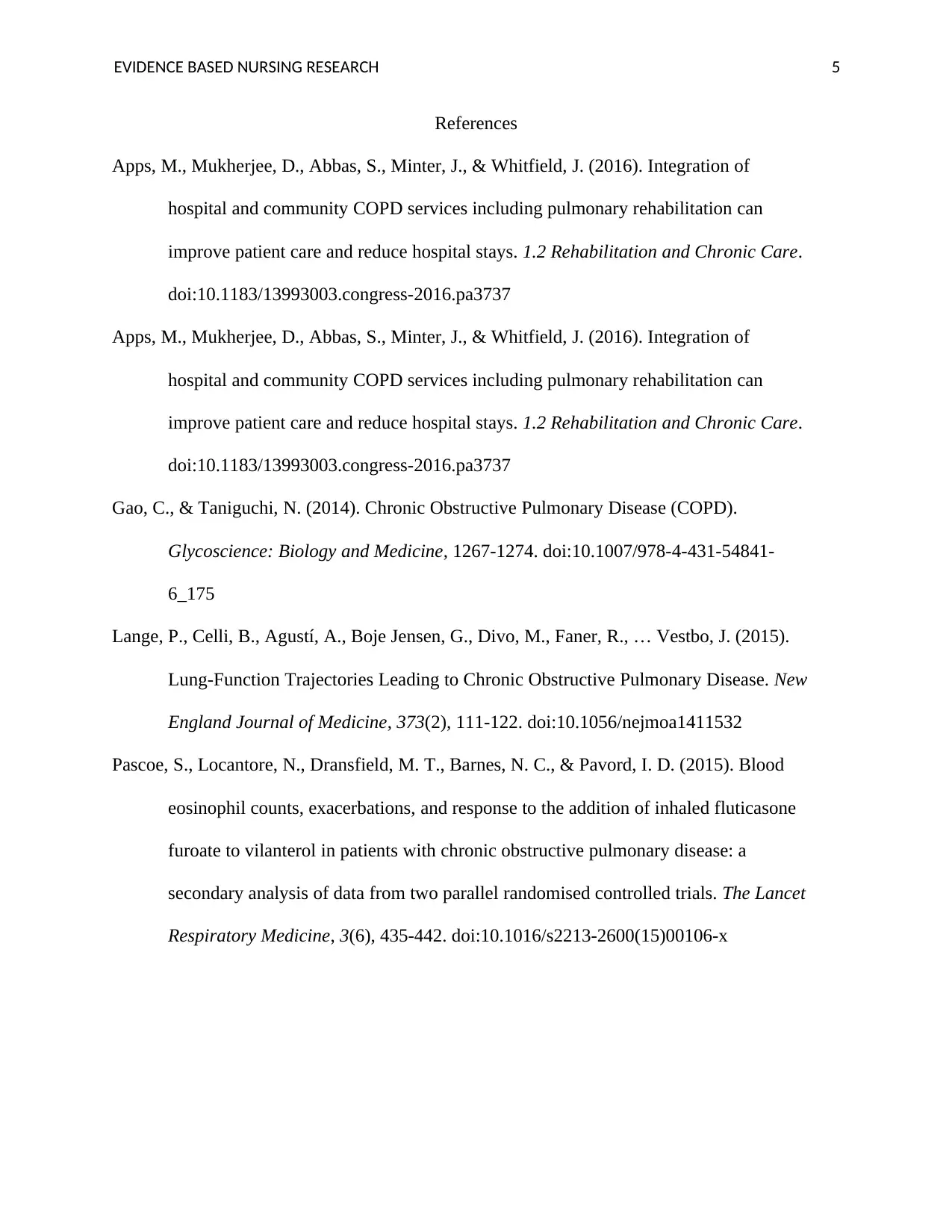
EVIDENCE BASED NURSING RESEARCH 5
References
Apps, M., Mukherjee, D., Abbas, S., Minter, J., & Whitfield, J. (2016). Integration of
hospital and community COPD services including pulmonary rehabilitation can
improve patient care and reduce hospital stays. 1.2 Rehabilitation and Chronic Care.
doi:10.1183/13993003.congress-2016.pa3737
Apps, M., Mukherjee, D., Abbas, S., Minter, J., & Whitfield, J. (2016). Integration of
hospital and community COPD services including pulmonary rehabilitation can
improve patient care and reduce hospital stays. 1.2 Rehabilitation and Chronic Care.
doi:10.1183/13993003.congress-2016.pa3737
Gao, C., & Taniguchi, N. (2014). Chronic Obstructive Pulmonary Disease (COPD).
Glycoscience: Biology and Medicine, 1267-1274. doi:10.1007/978-4-431-54841-
6_175
Lange, P., Celli, B., Agustí, A., Boje Jensen, G., Divo, M., Faner, R., … Vestbo, J. (2015).
Lung-Function Trajectories Leading to Chronic Obstructive Pulmonary Disease. New
England Journal of Medicine, 373(2), 111-122. doi:10.1056/nejmoa1411532
Pascoe, S., Locantore, N., Dransfield, M. T., Barnes, N. C., & Pavord, I. D. (2015). Blood
eosinophil counts, exacerbations, and response to the addition of inhaled fluticasone
furoate to vilanterol in patients with chronic obstructive pulmonary disease: a
secondary analysis of data from two parallel randomised controlled trials. The Lancet
Respiratory Medicine, 3(6), 435-442. doi:10.1016/s2213-2600(15)00106-x
References
Apps, M., Mukherjee, D., Abbas, S., Minter, J., & Whitfield, J. (2016). Integration of
hospital and community COPD services including pulmonary rehabilitation can
improve patient care and reduce hospital stays. 1.2 Rehabilitation and Chronic Care.
doi:10.1183/13993003.congress-2016.pa3737
Apps, M., Mukherjee, D., Abbas, S., Minter, J., & Whitfield, J. (2016). Integration of
hospital and community COPD services including pulmonary rehabilitation can
improve patient care and reduce hospital stays. 1.2 Rehabilitation and Chronic Care.
doi:10.1183/13993003.congress-2016.pa3737
Gao, C., & Taniguchi, N. (2014). Chronic Obstructive Pulmonary Disease (COPD).
Glycoscience: Biology and Medicine, 1267-1274. doi:10.1007/978-4-431-54841-
6_175
Lange, P., Celli, B., Agustí, A., Boje Jensen, G., Divo, M., Faner, R., … Vestbo, J. (2015).
Lung-Function Trajectories Leading to Chronic Obstructive Pulmonary Disease. New
England Journal of Medicine, 373(2), 111-122. doi:10.1056/nejmoa1411532
Pascoe, S., Locantore, N., Dransfield, M. T., Barnes, N. C., & Pavord, I. D. (2015). Blood
eosinophil counts, exacerbations, and response to the addition of inhaled fluticasone
furoate to vilanterol in patients with chronic obstructive pulmonary disease: a
secondary analysis of data from two parallel randomised controlled trials. The Lancet
Respiratory Medicine, 3(6), 435-442. doi:10.1016/s2213-2600(15)00106-x
1 out of 5
Related Documents
Your All-in-One AI-Powered Toolkit for Academic Success.
+13062052269
info@desklib.com
Available 24*7 on WhatsApp / Email
![[object Object]](/_next/static/media/star-bottom.7253800d.svg)
Unlock your academic potential
Copyright © 2020–2025 A2Z Services. All Rights Reserved. Developed and managed by ZUCOL.




